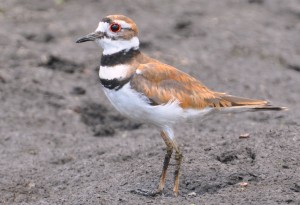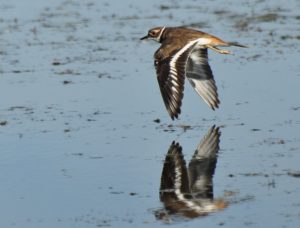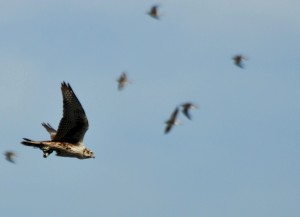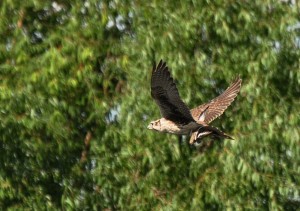Photography courtesy of Lowell Washburn, all rights reserved.
Saturday morning and a large scale bird migration was in full swing. I had hunkered into the soggy edge of North Iowa mudflat to enjoy the show as flocks of blue-winged teal, mallards, green-wings, pintails, shovelers, yellowlegs, and killdeer moved above the wetlands. A good number of teal, killdeer and yellowlegs had stopped to explore and probe the flats for food.
Feeding shorebirds always attract hunting raptors and, every few minutes or so, the birds would rise in unison as a migrating Cooper’s hawk tried to make the most of the opportunity. As soon as the hawk passed, the birds would settle in again and continue feeding as if nothing had happened. This went on for a couple of hours until mudflat suddenly erupted in complete pandemonium as a cloud of shorebirds rose in complete panic. Sounding the alarm, birds darted in every direction in a scene of complete chaos. The reason for the unprecedented commotion became apparent when a large falcon loomed into view. At first I thought the bird was a passage [immature] peregrine. Then, much to my amazement, I saw that it was a prairie falcon. Cousin to the peregrine, the prairie falcon is a bird of the Western high desert. I rarely see one in North Iowa [By “rarely” I mean one ever few years] and when I do, it is almost always during the dead of winter. I’ve never seen, or even heard, of one one occurring here in September or October.
With incredible speed and agility, the prairie picked a target and made its move. The wildly maneuvering, panicked killdeer never had a chance. In less time than it takes to tell, the falcon had overtaken and grasped its prey in a deadly grip. Never missing a wing beat, the bird reached down and instantly dispatched its victim with a bite to the neck. Following the edge of large willow batt, the falcon left the marsh and settled onto a prairie hilltop to pluck and devour its meal. I was thankful for the opportunity to view this exceptionally rare wetland event.





 Tom Cope
Tom Cope Sue Wilkinson
Sue Wilkinson Susan Judkins Josten
Susan Judkins Josten Rudi Roeslein
Rudi Roeslein Elyssa McFarland
Elyssa McFarland Mark Langgin
Mark Langgin Adam Janke
Adam Janke Joe Henry
Joe Henry Kristin Ashenbrenner
Kristin Ashenbrenner Joe Wilkinson
Joe Wilkinson Dr. Tammy Mildenstein
Dr. Tammy Mildenstein Sean McMahon
Sean McMahon